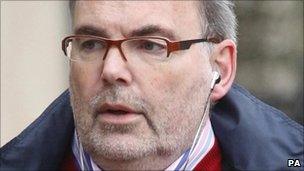Malcolm Webster trial: Doubt cast on crash details
- Published

Claire Morris was allegedly murdered by her husband in 1994
A car crash and fire in which a woman died could not have happened as her husband described to police, a murder trial has heard.
Malcolm Webster, 51, denies murdering his first wife Claire Morris in 1994 in Aberdeenshire for insurance money.
The High Court in Glasgow heard that expert witness Dr Hugh Barron thought it likely the car crashed at under 20mph (32km/h).
Mr Webster also denies crashing a car in a bid to kill his second wife.
He allegedly tried to murder Felicity Drumm in New Zealand in 1999.
Dr Barron, 67, an engineering professor at the University of Aberdeen who compiled a report on the Aberdeenshire crash, was too ill to give evidence in person.
Instead, his evidence was played to the jury in a pre-recorded video.
He said he tried to work out what speed the vehicle was travelling at before it stopped.
The trial earlier heard Mr Webster, from Guildford, Surrey, told police he was travelling at 25mph (40km/h) in the Diahatsu Sportak when he swerved off the road to avoid a motorcyclist on the wrong side of the road.

Malcolm Webster has denied all the charges against him
In his conclusion, Dr Barron said: "It is most probable that to end up in its final position the Diahatsu would have to be driven off the road in a straight line at speeds of less than 20mph."
The court heard that Dr Barron gave his findings to a company which produced animations, using geometry and physics, of what would have happened to the Diahatsu at 25mph (40km/h) and at 20mph (32km/h).
Dr Barron said that this showed it was not possible for the accident to have happened the way Mr Webster told police it had.
Advocate depute Derek Ogg QC, prosecuting, asked: "If we take the speed given by Malcolm Webster, or even five miles less, the vehicle can't end up in the position it did?"
Dr Barron said: "Absolutely."
Conclusion stands
Dr Barron said that if the car was being driven at 25mph (40km/h) as suggested by Mr Webster, the only way the Diahatsu could have ended up where it did was if it made a wide arc onto the opposite side of the road and into a field.
Mr Ogg said: "It was not suggested by Mr Webster that the car went over to the other side of the road, but it would have had to do something like that to end up where it did?"
Dr Barron replied: "That's correct."
Mr Barron was shown a defence report which suggested his conclusions could be wrong because he did not take into account the car spinning round after impact.
He said that if the vehicle did spin it would have been so slight that his conclusion would still stand.
The court heard Dr Barron had to return for a second day because the judge forgot to ask him to take the oath.
Lord Bannatyne admitted to the jury that forgetting to swear in the expert witness was "not one of my best moments".
Mr Webster also denies intending to bigamously marry Simone Banarjee, from Oban, Argyll, to gain access to her estate.
The trial continues on Friday.
- Published6 April 2011
- Published5 April 2011
- Published4 April 2011
- Published1 April 2011
- Published31 March 2011
- Published30 March 2011